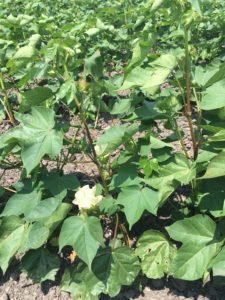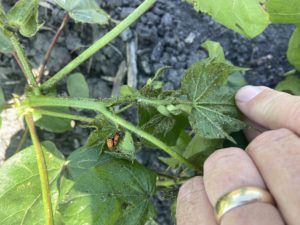 Cotton plant maturity ranges from 9-14 true leaves. We began seeing blooms in a few fields. The fields with blooms had 6-7 nodes above white flower, which shows the effect of drought stress.
Cotton plant maturity ranges from 9-14 true leaves. We began seeing blooms in a few fields. The fields with blooms had 6-7 nodes above white flower, which shows the effect of drought stress.
The water demand of a crop increases significantly as bloom nears and fruit production begins. If we do not get rainfall soon, expect to see wilting cotton fields in the afternoons.
Fortunately, we have not seen insect pressure requiring insecticide applications. Cotton fleahoppers have been difficult to find in most fields. Few fields have more than 5 cotton fleahoppers per 100 plants. And no fields have been found above the economic threshold of 15 per 100 plants.
Generally we assume the damage window of the cotton fleahopper closes in the first week of bloom.
Once a field begins to bloom, we can switch from searching for cotton fleahoppers to looking for stink bugs and evidence of their feeding. Scouting for stink bugs involves opening cotton bolls and looking for wart growth or lint staining on the inside of the boll. Spots on the outside of the boll do not necessarily mean the feeding went inside of the boll wall so be sure to open the boll and look inside.
In the first week of bloom, stink bugs rarely cause economic damage, so use a threshold of 50% internal feeding to trigger a spray.
Cotton aphids are being found in small pockets of some fields. Often this infestation is only on l2-3 plants. Most of these problems will be solved by predators such as lady bugs and syrphid fly larvae eating the aphids so don’t be in a hurry to treat aphids. It is best to mark the spot and return in 3-5 days.
